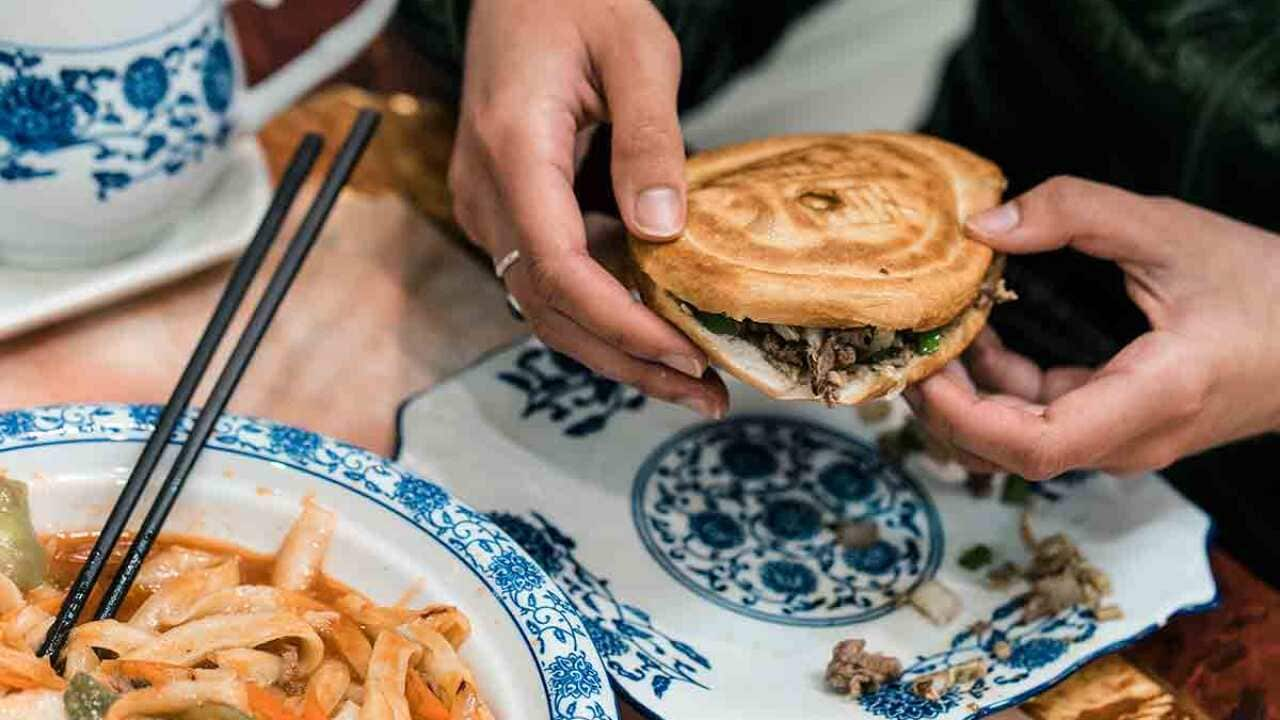When I arrived in China, I wasn’t prepared for how much bread I was about to devour. I’d prepared my stomach for endless noodle bowls and towers of dumplings. But bread? How much bread do Chinese people really make? Turns out, it’s a lot.
The story of Chinese bread begins in the Han Dynasty, about 1500 years ago when rotary stone flour mills became popular across the country. Chinese kitchens have always lacked conventional ovens, and are still rarely used today, so steaming was the method of choice to cook soft, leavened bread known as mantou.
Centuries later during the Tang Dynasty, Arab traders travelling along the silk road between China and the West spread their culture, religion and food. Crisp, flaky baked bread infiltrated the country, cooked in cylindrical clay tandoor ovens.
On my trip through China I ate bread every day, bread so tasty I rejected the thought of ever craving a crusty sourdough from my local Sydney bakery again. This list of local bread, roasted over coals, fried or baked on the street, are traditional snacks eaten almost everywhere, and a central part of Chinese cuisine.
Flaky sesame breads (shao bing)
Rippled with lard, green onion and chilli oil, these guys come in a bunch of regional varieties. Lakeside in Hangzhou you’ll find them crispy and flat, while in Jinhua they’re rolled into small balls and known more commonly as su bing. Either way – you’re going to want to order up.

Source: Leigh Griffiths
Steamed buns (mantou)
The original Chinese bread, these pillowy buns are made with a yeasted dough and steamed in large trays to stay soft and warm. Traditionally mantou is plain, but these days you can find plenty of new incarnations, including green onion, sweet potato or brown sugar. Hot tip: look for a billowing steam signal and a gathering crowd for the freshest batch.
Stuffed steamed buns (bao-zi)
An ingenious cross between mantou and dumplings, bao-zi are smaller buns stuffed with an infinite list of fillings, and a popular breakfast in China’s south. Inside the thick, spongey casings you’ll find either pork, pickled greens or sweet red bean paste. A brekky you can grab on the go that sure beats a muesli bar. Chinese steamed buns filled with crisp, spiced chicken. Get this supreme sandwich .
Chinese steamed buns filled with crisp, spiced chicken. Get this supreme sandwich .

Chinese steamed buns filled with crisp, spiced chicken (mantou jiaoyan ji).
Fried breadsticks (you tiao)
Another quintessential Chinese breakfast involves a couple of these freshly fried sticks beside a bowl of warm soy milk or congee. Cantonese cooks will serve them wrapped in rice noodles, while Northern Chinese wrap the crunchy sticks in shao bing. Carb on carb action – is there anything better?
Uyghur flatbreads (nang)
Wheat breads have been staples of North-Western China for centuries, and among the two listed here, another 40 types of breads are said to exist in Xinjiang and surrounds. You can’t miss the round stacks of patterned nang cooling on city streets, sprinkled with sesame seeds and spices to serve.
Uyghur bagels (girde nan)
A pocket-sized version of the larger wheels of nang, these crisp are baked over hot coals not boiled like European bagels. Unlike nang, which is easier on the teeth when eaten cool, these must be eaten fresh from the oven and are commonly served with tea.

Uighar (Uigar) bread and naan for sale in the streets of Kashgar. Source: Getty Images
Yunnan ‘pizza’ (baba)
Touted by locals as ‘Chinese pizza’, this flaky, lard-filled bread deserves more credit than a Western rip-off. Roasted over coals, these piping hot pockets come in many ethnic variations. Glutinous rice flour is preferred in southern Yunnan, while wheat flour is used by the northern Naxi people of Dali. Sweet baba is filled with brown sugar and rose jam – a typical ingredient throughout Yunnan.
Xian burger (rou jia mou)
Half kebab, half burger, a few late-night are an essential part of street food snacking in Shaanxi province. Doughy white mo flatbreads are filled with carved pork (or beef in the Muslim quarter of Xi’an) and a green chilli gravy.

Source: Brett Stevens
Green onion pancakes (chou you bing)
Made with a dough rather than a batter, chou you bing are a popular pick in Chinese restaurants in Australia. But in China, these are more likely found on the streets, in hole-in-the-wall bread shops. Rolled in huge batches, shallow-fried on large pans and chopped, they're sold by the gram.
Love the story? Follow the author here: Twitter or Instagram . Photographs by .
Bask in a Chinese food bounty like no other in Adam Liaw's brand-new series airing 7.30pm Wed nights on SBS, with an encore Sun 9.30pm on SBS Food (Channel 33) and then after broadcast via Join the conversation #DestinationFlavour on Instagram , Facebook and Twitter . Check out for recipes, videos and more!
Destination Flavour China is sponsored by Cathay Pacific. For more information, please visit 

Source: Cathay Pacific




